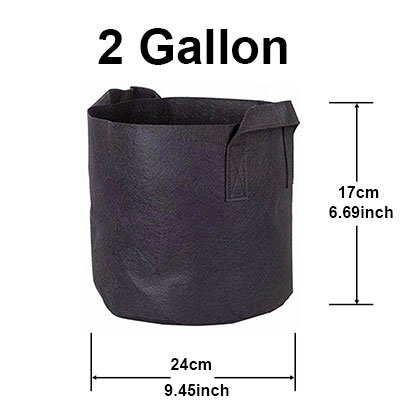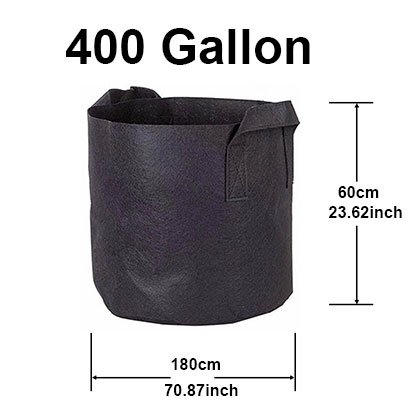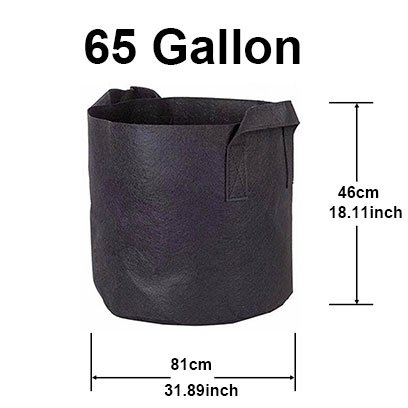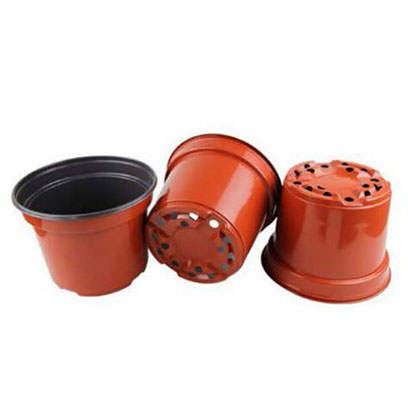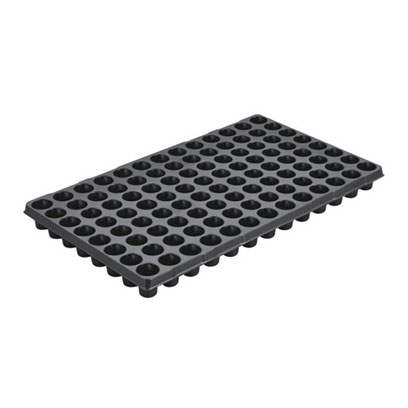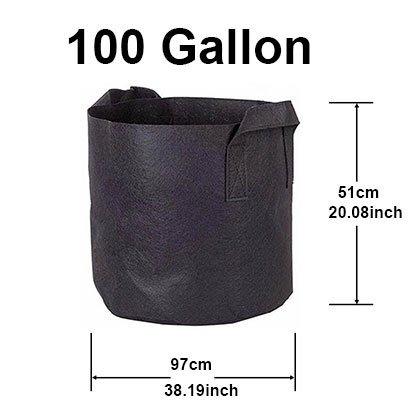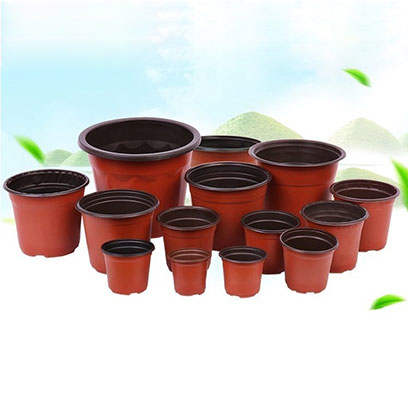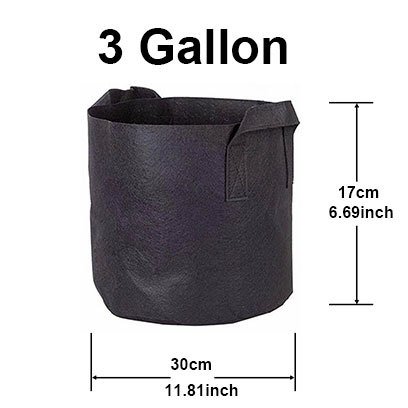Raspberry is one of the most popular berry plants. In addition to strawberries, you also want to plant berry plants in plastic plant pots. Raspberry is a good choice. Raspberry usually results from May to August, and some varieties result from August to October, which are slightly different due to the difference of varieties.
Cheap Raspberry Bush Planters Wholesale MOQ:1000pcs! 19 Years Experience Raspberry Plant Pots Supplier, 35,000m² Workshop Area, Factory Price, Free Samples!
If you want to buy raspberry plant pots, please click our products: Plastic Gallon Pots or Plastic Terracotta Pots or Fabric Gallon Pots for more information!
Raspberry can bear fruit continuously for many years after planting. When growing raspberries in pots for the first time, you can first go to the flower market to buy seedlings, preferably varieties with less diseases and pests. After the raspberry is raised in the future, its healthy branches can be used for raspberry pots cutting propagation!
1. Types of raspberry bushes
In fact, there are many varieties of raspberries, and the fruits also have different colors, including the common red, yellow, purple, black and gold varieties, which will have different flavors. The species of raspberry can be divided into two categories according to its fruiting season. Summer raspberries will produce berries throughout the summer.
Raspberries suitable for all seasons will harvest fruits in summer and autumn. Raspberry plants in pots has proper shade tolerance and can grow in a place with half shade and half sunshine, but it's best to give as much light as possible. Raspberries in pots can bear more fruit in a sunny environment, otherwise it will only grow leaves and not bloom.
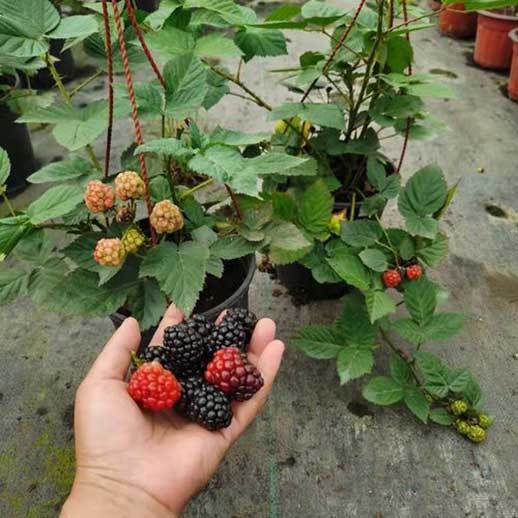
Raspberry bush in pot is generally cold resistant and should not be cultivated in cold winter. However, if it is an area without frost, it can be planted from October to March. Autumn or spring are good planting times. Raspberry varieties also produce fruits in different colors, from red and dark purple to surprisingly golden berries.
It is also very simple to grow raspberries in containers. It is generally carried out by cutting in late spring and early summer. Cut a section of branches with more than 2 ~ 3 nodes, remove the leaves at the bottom, slightly stained with rooting powder, and then cut them into loose and well drained sandy soil to keep the soil moist. Generally, they can take root in two or three weeks.
2. Best pots for raspberries
You only need to do a few things to grow raspberries in the best environment. However, the first thing to do is to start with the selection of raspberry bush planters. Raspberry is a kind of shrub plant that is easy to spread. It is also a good choice to use raspberry plant pots for maintenance, but choose raspberry pots with appropriate size. Raspberry planters should be at least 15 to 24 inches in diameter and at least 60 centimeters deep.
When choosing planter for raspberries, try to choose larger ones. You need at least 5 gallon pot. In this way, raspberries in containers will not lack space to grow when they want to bear fruit. Too small raspberry plant pots will not provide enough space for raspberries to grow. In addition, the air permeability and drainage of the raspberry bush planters must be good, and the raspberry pots bottom must be selected with drainage holes.
Select appropriate compost soil for planting, and ensure that the soil can not dry too fast and has a certain water holding capacity. However, after three years of maintenance in the raspberry bush planters, the raspberry will grow very large and need to be transplanted into new raspberry plant pots. Remember, pots for raspberries should allow more airflow and make the soil dry faster.
Pot for raspberry plant also need drainage holes so that water can escape rather than stay in the soil. You need to change raspberry pots gradually and put more energy into it. It is recommended to choose fabric grow bags with diameter of 40-60cm as the final raspberry plant pots, one pot for one tree.
Every year from March to April or September to November, after changing raspberry bush planters in early spring, the root system can absorb more nutrition, the new branches grow and the tree crown expands rapidly. It's hot in summer. Don't change raspberry planters at will. It's easy to stuffy roots and cause plant death in serious cases. Raspberry plant pots can also be changed one month before autumn and winter.
3. Best soil for raspberries
Raspberry mainly grows on the edge of miscellaneous trees, shrubs or wilderness in the mountains. At an altitude of 500-2000 meters, raspberry is common in the bushes in the sunny or shady places on the hillside and roadside. Raspberry likes a warm and humid growth environment, so the soil can choose peat soil with good water retention, add some humus soil with high organic matter content, and then add some sandy soil.
When planting raspberries in containers, we must use loose, breathable and well drained humus. The soil is rich in humus. Properly adding some manure or composting soil will help to grow well. If there is enough composting soil, we can promote flowering and fruiting. In addition, to ensure the air permeability and drainage of soil, perlite, vermiculite and river sand should be added appropriately. Proper drainage is important to keep plant roots healthy and rootless decay.
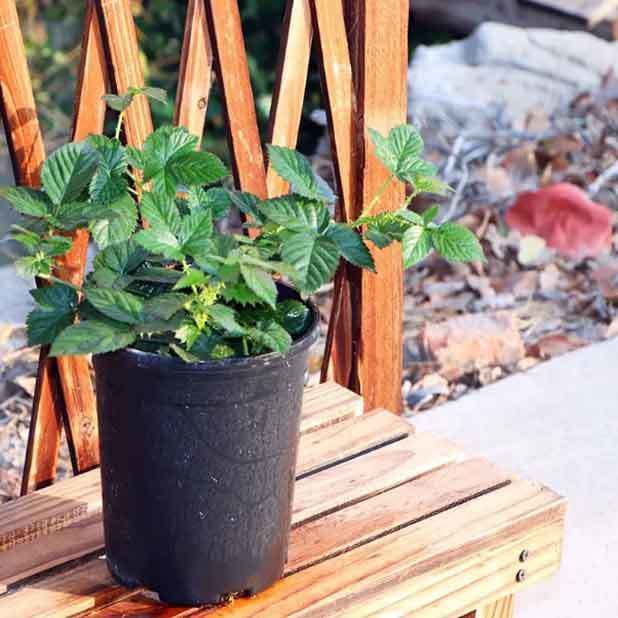
Before planting raspberry canes in pots, add a layer of rotten organic fertilizer to the bottom of the raspberry bush planters, then lay a layer of soil, and finally plant raspberries. Potted raspberries prefer acidic soil, so the potted soil should not only have sufficient nutrients and porosity, but also be acidic. You can go home and improve the pH of the soil yourself.
4. Growing raspberries in pots
During field planting and maintenance, the spacing of each row should be about two meters. The best planting position is to cultivate from north to south, so that the spacing between them will not shade each other. When growing raspberries in pots, we must choose some robust cuttings with less diseases and pests and adaptability to the environment. When planting raspberry canes after the warm spring, we can directly choose raspberry plant pots for maintenance.
It is best to choose raspberry bush container with large drainage holes and air permeability. Potted raspberry seedlings bought from the flower market usually carry a small soft raspberry bush pot. When transplanting, take down the original pot and soil. In this process, be careful not to damage the root system. Bury the potted seedlings in the raspberry bush planters.
The depth of burial is a little deeper than that in the original tree pot. Then pour root fixing water once and pour it through. If you buy a raspberry with bare roots, soak the roots in clean water for 6 ~ 8 hours before planting. If you have rooting solution, you can also soak it for 2 ~ 3 hours before planting, which is conducive to faster recovery of growth. Fill the bottom two inches with gravel. You also need to place spill trays under the raspberry pots. This will allow adequate drainage without wetting the floor or table.
Use a mixture of potted soil and compost to provide a good foundation for raspberry bushes in pots. Fill three-quarters of the raspberry planters with a soil mixture, and then plant the tree in a hole in the center of the raspberry pots. Make sure the hole is large enough to completely cover the root ball, and then plug the pot soil back around the plant. You can surround the plants with mulch to help the pots soil retain water, but this is not necessary.
5. Watering raspberry plants
After growing raspberry bushes in pots, it should be watered thoroughly. In the later maintenance and growth period, it only needs to keep the planters soil completely dry and watered thoroughly. It doesn't matter if you forget to water occasionally. Raspberry plants in pots is relatively drought resistant and should not be watered too often to ensure that the soil is moist. When there is drought in the raspberry plant pots, water it again, and pay attention not to ponding at ordinary times.
The place of maintenance should adhere to ventilation and light transmission to prevent it from being kept in a closed space. If it is kept on the balcony, there must be sufficient light every day, so that dwarf raspberries in containers can develop healthily. In the development period, it is necessary to supplement water on schedule. When the soil is about 5cm dry, it can be watered once. Indoor raspberries need more water than outdoor plants.
In the absence of rain and morning dew, it is important to ensure that raspberry in planter get enough water. Check the water in the soil of the raspberry planters every day and keep it moist at all times. In spring, water twice or three times a week. In summer, evaporation is strong, and the frequency of watering should rise. In autumn, there can be no shortage of water in the fruiting period. In winter, the number of watering can be appropriately reduced.
6. Fertilizer for raspberry bushes
Add rotten organic fertilizer to the bottom before the tree put into the raspberry pots. After the raspberry enters the growth period, the cake fertilizer after ripening and dilution can be applied every other month or so to increase the humus in the soil, which is beneficial to promote the growth.
Using water-soluble fertilizer to fertilize plants every month will also help plants maintain health and growth. Raspberry bush in container need more nutrients to bloom and bear fruit, so fertilization must keep up. During the incubation period of potted raspberry flower buds, phosphorus and potassium fertilizer should be added.
Do not use organic fertilizer or nitrogen fertilizer alone. Fertilizer for raspberry should be applied at least twice a month, and the amount of fertilizer can not be too much. After the weather gets a little cold in autumn, stop fertilization, continue to water the plants to keep the plants alive, and stay away from the indoor heater to avoid excessive drying of the pots soil.
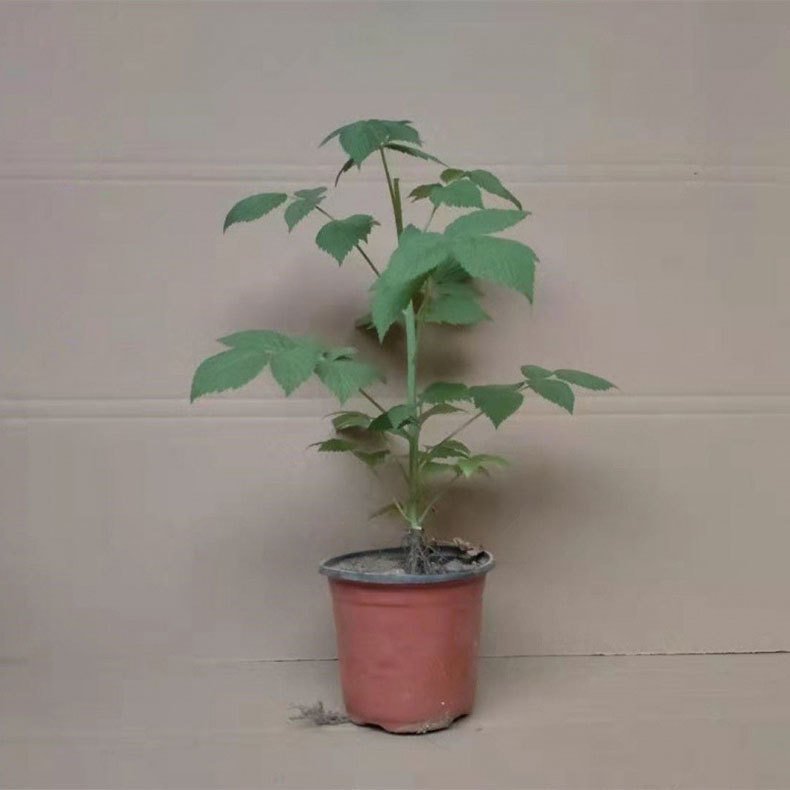
7. Illumination for raspberry bushes in containers
The best soil for raspberries in pots should not be too dry. Keep the soil of raspberry planters slightly moist in the first three or four weeks of planting. Then slowly see the light. If you want raspberries to bloom, you must have enough light. These raspberries in containers need to be placed on windows and exposed to direct sunlight for six to eight hours a day.
If raspberry bush in a pot do not get enough sunlight due to their placement, they may not grow normally or may not bear fruit. If you want to eat sour and sweet fruits, you must give raspberry canes in pots more sunshine. If the light is insufficient, they will produce few fruits, and the overall growth state of potted raspberries will be very poor. In addition, although potted raspberries like to bask in the sun, you can't let them directly bask in the summer sun. They must build a shading net to cover the sun.
8. Pruning raspberry bush in pot
How to prune raspberry bushes? Raspberry plants in pots should be properly built every year in order to keep the plant healthy. However, raspberry branches will have some sharp spines. Be sure to wear gardening gloves before pruning. Pay attention to check when pruning. All brown withered branches should be cut off and some green branches should be retained. In addition, pay attention to appropriate thinning and cut off some overcrowded branches.
When to prune raspberry bushes? The key is to prune every year, especially when it is dormant in winter, cut off about 2 / 3 of the branches of raspberries in pots, and grow new branches and leaves in the coming year, which will make it bear more fruit. The raspberry will bear fruit about a year after it is planted in the raspberry plant pots. After the result is once, the branches and leaves will dry up and grow new branches instead, which means you have to prune the raspberry during dormancy.
It is usually pruned when the leaves wither in late autumn, or even directly to the ground. As long as the roots are not frozen to death, they can still grow again in the coming year. After the branches and leaves stop growing in winter, trim them from the bottom of the rhizome upward, keep the rhizome at the bottom, cut off most of the branches and leaves, and cut off the withered branches to avoid overcrowding.
When the dried branches of potted raspberries appear, be sure to trim them in time. In addition, if some branches of raspberry grow too dense, they also need to be trimmed to ensure that each branch has enough space to bear fruit. It is suggested that you can directly observe the full sprouts and dead buds after 3 months. Some branches and leaves can also be cut off in summer.Cut off the diseased branches, dead branches, weak branches and crossed branches of raspberry.
Pay attention to cut off the dry part at the top of the fruit bearing branches of the previous autumn. The cut should be cut until the green branches are exposed. The new wound will heal completely to avoid the branches from infecting bacteria. If the raspberry plant is not plump enough, you can appropriately cut more old branches down, and the edge of the raspberry bush planters is about 25cm, so as to promote the germination of new branches at the base.
Cut off the old branches that bear fruit for two consecutive years from the base, promote the germination of new branches at the base, keep the plant young and vigorous, and enhance the ventilation and light between branches at the same time. When raspberry bush in planter grow up, about 20 strong old branches are screened out for each plant, that is, the branches with fruit hanging in the autumn of the previous year. The distance between branches should be kept at about 10cm. After fruit bearing in summer, the branches with fruit bearing in summer can be combed properly. Let the fruit bearing branches grow fully in autumn.
9. Raspberry bush care
When growing raspberries in pots, we must pay attention to regularly removing weeds. All kinds of weeds growing next to raspberries will affect growth. After removing all weeds, we should also pay attention to appropriate soil covering. It is best to cover the soil surface with a layer of woven ground cover, which is conducive to maintaining moisture and temperature and preventing weeds from growing in.
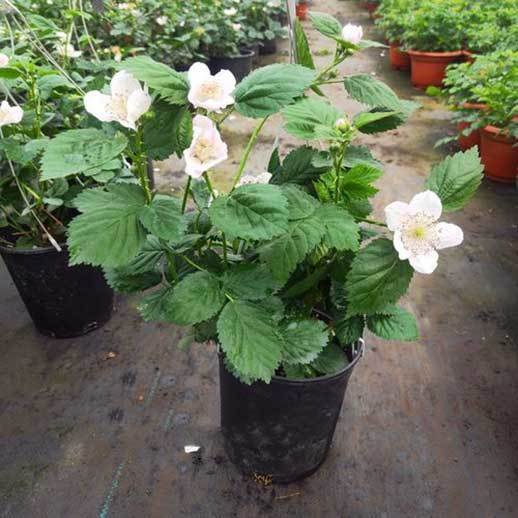
One of the most important ways to assist indoor raspberries is to help with manual pollination. Indoors, it will not benefit from pollinating insects, such as bees and butterflies, so you need to lend a helping hand. After the raspberry blooms, use a small brush to move the pollen in the flower to the center of the flower. You can do this several times to ensure complete pollination.
During grow raspberries at home, sufficient light shall be added as much as possible. The maintenance position shall be ventilated and transparent. When watering, avoid pouring directly on the leaves. Do not water the raspberry plant pots before the soil is dry. After the raspberries bear fruit, they can be covered with barbed wire or other nets to avoid being eaten by birds.
10. Diseases and insect pests of indoor Raspberry
Beetles, such as Japanese beetles and raspberry beetles, can also nest in raspberry plants. Raspberry beetles feed on the flowers of plants. Their larvae feed on berries and can be found in berries. Japanese beetles eat and destroy the leaves of plants. They usually appear in groups and are known for their metallic green. Their larval larvae feed and damage their roots. Lay eggs in raspberry sugarcane.
When the eggs hatch, the little beetle will hurt the plant, and then the larvae enter the soil and feed on its roots. Aphid is a common pest of raspberry. They absorb juice from the leaves of plants and grow strong, which will cause the leaves and leaves to turn yellow and die. Their sweet secretions can also attract ants. Raspberry plants in pots are also susceptible to different viruses and fungi, such as orange rust and sugarcane wilt. These are usually spread by rain and wind, so raspberries left indoors should be less likely to have these problems.
11. Supporting raspberry canes
Raspberry branches are easy to fall down. In order to avoid falling down due to long growth of old branches, we need to install some fixed supports around raspberries. This can support the branches of raspberry, so as not to fall down and affect fruit setting. In addition to the wooden support, you can also choose to use barbed wire as a frame to let the raspberries climb up and grow.
Potted raspberry can choose to use three-dimensional ring support to circle the branches. Growing raspberry bushes on the ground can draw several steel wires horizontally and tie the old branches evenly to the steel wires. The binding spacing shall be kept at about 10cm, leaving a certain growth space for sunlight to be transmitted into the plant. The maximum installation height of support or steel wire is 1-1.5m.
By adding wire plant cages around raspberry plants, the structure is added to indoor raspberry plant pots. You can also use slender bamboo and rattan as a support for the raspberries in pots, and then tie it to the top with a rope. You will want to make sure that these structures are several inches higher than your plants. As raspberries grow, new growths continue to be attached to the structure to provide support.
12. Harvest raspberries
Raspberry belongs to a small shrub. It bears fruit very early and is easy to enter the full fruit period. Generally, the fruit can be seen two years after planting. It has a high yield in 3 years, the highest yield in 4-5 years, and the full fruit period can be as long as about 15 years. The root system is shallow, not drought resistant, and insufficient water will inhibit growth and fruit bearing. The evaporation of soil water in raspberry plant pots is relatively large, and insufficient water will affect the yield in the period.
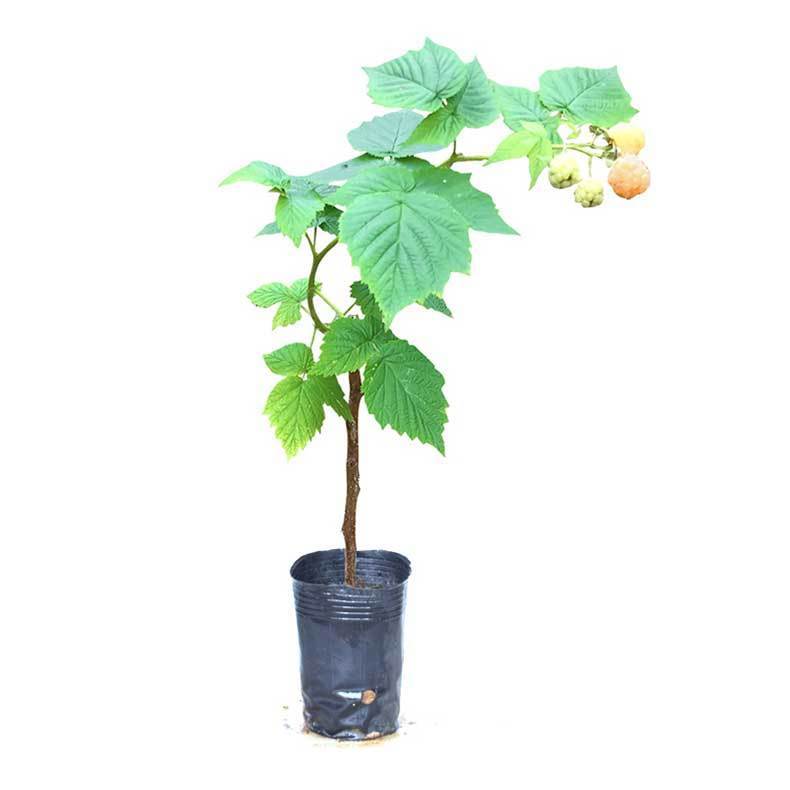
Double season raspberries can be harvested in summer and autumn. The new branches from the old branches bear fruit from April to May and are harvested from May to June. The new branches extracted from the base bear fruit from August to September and are harvested from September to October. The seedlings can bear fruit in that year, but the amount of fruit is relatively small. Generally, the plants enter the high-yield period after 2-3 years of planting in raspberry bush planters.
Don't rush to pick the small berries of raspberries after they are mature. If you find that their berries are easy to fall off, you can harvest them. At this time, you must pick them as soon as possible. Their fresh-keeping period is very short. The best way to keep raspberries fresh is to put them in bags and then put them in the refrigerator.
Raspberries do not fully bear fruit until the second year of growth. Once your raspberries turn crimson, they can be harvested. Raspberries in less common colors should look bright and full. Pick them, wash the fruit, and enjoy. You can even freeze the berries for later use. Planting and cultivating fruit trees requires a little patience and careful learning of pruning methods. In this way, we can cultivate strong raspberries, so as to bloom and produce high yields every year.








